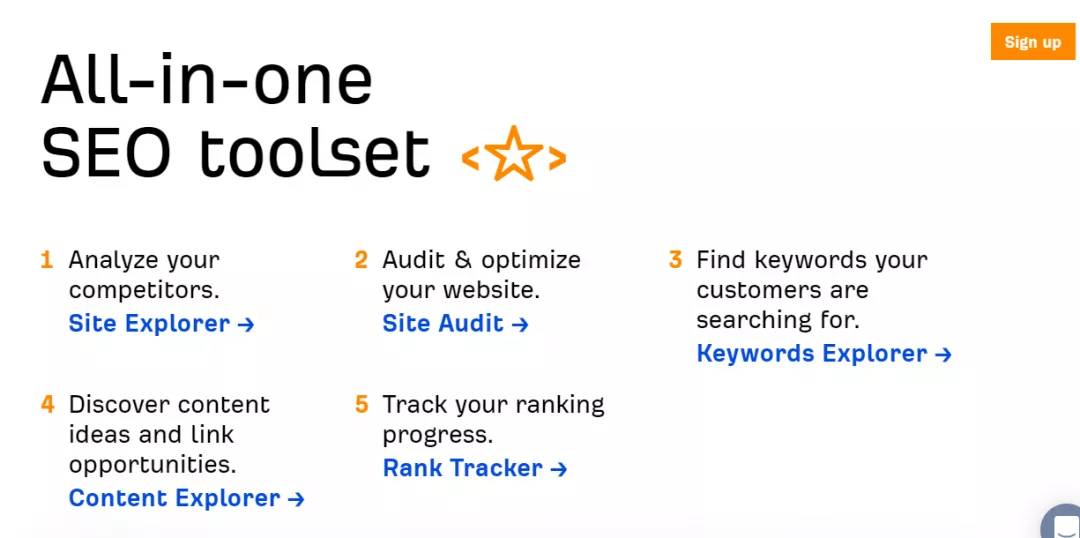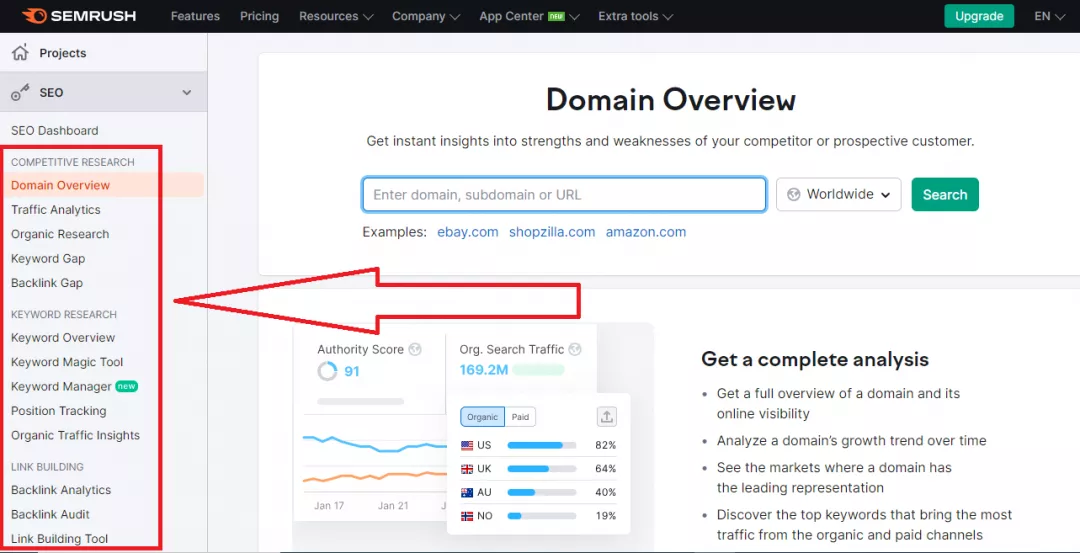What Is SEO Competitor Analysis?
SEO competitor analysis involves examining how other websites optimize for search engines and extracting insights to improve your own strategy.
The key objectives are to understand:
Which keywords your competitors are targeting to improve visibility
The techniques they use to achieve higher rankings
Where they acquire backlinks from
How they perform across essential SEO metrics
This analysis helps you uncover what strategies work well in your industry. You can apply these learnings to enhance your SEO plan and improve your site’s performance.
Why Is It Important?
Conducting SEO competitor research is critical for several key reasons:
Identifying New Opportunities
Analyzing competitors reveals untapped market opportunities.
You may uncover keyword gaps your competitors haven’t targeted yet, giving you a chance to get ahead.
Understanding Effective Strategies
You can see which tactics are delivering strong results for your rivals. By studying their success, you can adopt similar techniques to boost your own visibility.
Recognizing Weak Points
Competitor research also exposes areas where they may be underperforming. This allows you to avoid their mistakes and create a more refined strategy.
Staying Adaptive
Search engine algorithms and competitor tactics are always evolving. Monitoring these shifts lets you adjust your own approach in real time.
Discovering Keywords and Content Ideas
Competitor analysis often reveals new, relevant keywords and content ideas, opening up new ways to drive organic traffic.
Strengthening Backlink Strategy
High-quality backlinks remain vital for SEO. Studying where your competitors get theirs can help you find valuable link-building opportunities.
Understanding Audience Behavior
By reviewing competitor content and how users interact with it, you gain insights into what appeals to your target audience—helping you create more engaging material.
Optimizing Resource Allocation
Knowing what works allows you to focus time, budget, and effort on high-impact strategies instead of trial and error.
When Should You Study Your Competitors for SEO?
Competitor research should be a recurring part of your SEO efforts since market dynamics, algorithms, and competitor activity continuously change.
Here are the best times to conduct SEO competitor analysis:
During Content Planning
Before developing new content, assess what’s performing well for competitors. Check their top-ranking keywords and topics.
This helps you create competitive content that ranks and prepares you for the level of effort needed.
After Publishing New Content
After releasing new content, measure its performance against your competitors.
Analyze rankings, traffic, and engagement to see if optimizations are needed to improve results.
When Rankings Shift
If your rankings drop or a competitor surpasses you, investigate their SEO updates.
Learning what they did right helps you adjust and reclaim your position.
Following a Ranking Drop
If your site experiences a ranking loss, compare your strategies with those of competitors to uncover potential issues or gaps you need to address.
Download our free competitive analysis template to improve your site's SEO.
Types of Competitive Analysis
You can perform SEO competitor analysis through three primary methods:
Content Analysis
Content is a key SEO pillar. Reviewing your competitors’ most successful pages gives you ideas to strengthen your own content strategy.
Look at what types of content perform best and attract high traffic—then create something even more relevant and useful for your audience.
Two powerful methods to beat competitor content:
Content Gap Analysis
This approach identifies missing content or undercovered topics on competitor sites. You can fill these gaps by producing content that addresses those overlooked areas.
Learn more about Content Gap Analysis here.
The Skyscraper Technique
Popularized by Brian Dean of Backlinko, the Skyscraper Technique improves your ranking by creating superior content on a given topic.
Here’s how it works:
Find a widely shared and well-linked article in your industry.
Create something significantly better by:
Adding more in-depth information
Updating data and insights
Using visuals like images, videos, or infographics
Once your enhanced article is live, reach out to sites linking to the original and suggest they update their link to your improved content.
This method helps you build backlinks and increase authority.
Backlink Profile Analysis
High-quality backlinks boost rankings by signaling trustworthiness to search engines.
But not all backlinks are beneficial. Links from spammy or irrelevant sites can hurt your performance.
Here’s how to improve your backlink profile:
Backlink Relevance
Ensure backlinks point to relevant content. The more aligned the topic, the better it supports your authority.
Aim for diverse backlinks across multiple pages, not just the homepage.
Unlinked Brand Mentions
Look for online mentions of your brand without a hyperlink. Reach out and ask for a clickable backlink to convert mentions into SEO value.
Competitor Backlink Insights
Study how competitors earn backlinks. Analyze what kind of content attracts links, then create superior versions to earn similar (or better) backlinks.
Technical SEO focuses on your website’s infrastructure and compares it to that of your competitors.
It helps uncover technical flaws that might be holding your site back.
Key areas to evaluate include:
Internal Linking
Use clear, descriptive anchor text to link between pages. This helps users navigate and improves how search engines crawl your site.
Site Architecture
Maintain a clean, easy-to-navigate site structure. Ensure all important pages are reachable within four clicks from the homepage.
Speed and Security
Pages should load quickly and use HTTPS for security. Fast, secure sites improve user experience and ranking potential.
Mobile Optimization
Your entire site must be responsive and function well on all devices. Google prioritizes mobile-friendly content.
Technical SEO Analysis
Technical SEO focuses on your website’s infrastructure and compares it to that of your competitors.
It helps uncover technical flaws that might be holding your site back.
Key areas to evaluate include:
Internal Linking
Use clear, descriptive anchor text to link between pages. This helps users navigate and improves how search engines crawl your site.
Site Architecture
Maintain a clean, easy-to-navigate site structure. Ensure all important pages are reachable within four clicks from the homepage.
Speed and Security
Pages should load quickly and use HTTPS for security. Fast, secure sites improve user experience and ranking potential.
Mobile Optimization
Your entire site must be responsive and function well on all devices. Google prioritizes mobile-friendly content.
How to Do Competitive Analysis for SEO?
Here’s a step-by-step breakdown:
1. Identify Your Competitors
Start by finding out who your SEO competitors are. These may differ from your direct business rivals.
Search for key terms in your niche and examine the top 10–20 results to identify strong competitors.
2. Analyze Top Pages
Review the highest-performing pages on your competitors' sites. Identify keywords they rank for that you don’t.
This helps inform your content plan to target those missed opportunities.
Also, analyze backlinks—how many, where they come from, and what content they're linked to.
3. Prioritize High-Value Keywords
Don’t try to rank for everything. Focus on keywords with high potential to drive leads or revenue.
Look for profitable keywords your competitors aren’t targeting.
4. Build a Content Strategy
Use your findings to create a detailed content plan. Choose target keywords and brainstorm content ideas.
Publish new content and improve existing pages. If needed, initiate backlink outreach to support ranking.
5. Monitor and Optimize
Track your keyword positions, traffic, and other SEO metrics regularly.
Other Things To Do
Backlink Growth Tracking
Analyze the monthly backlink growth of competitors. Compare referring domains year-over-year to set link-building benchmarks for your own efforts.
Organic Keyword Research
Identify which keywords drive organic traffic to your competitors. Group them into categories like blog posts or landing pages.
Focus on achievable, high-impact keywords.
Featured Snippets Optimization
See which competitors appear in featured snippets. Study how they format content and replicate that style for your own keywords.
Traffic by Country
Review the geographic traffic distribution for competitor websites. Prioritize high-traffic countries and explore growth potential in under-served markets.
Broken Link Opportunities
Find competitor pages that had backlinks but are now offline. Create better content on the same topics and ask linking sites to redirect to your page.
Top-Linked Competitor Content
Identify which competitor pages attract the most backlinks. Use this insight to create similarly valuable, link-worthy content.
Search Intent Focus
Align content with user intent. High-volume keywords mean little if your content doesn’t satisfy what users are looking for.
Long-Tail Keyword Targeting
Go after specific long-tail keywords with lower competition and higher conversion potential.
Analyze Traffic Sources
Monitor where your competitors’ traffic comes from—organic, social, referral, or direct.
This shows which channels you might want to invest in.
Offer More Value
Don’t settle for parity. Strive to create content that’s noticeably more helpful, insightful, and engaging than your competitors’.
Study Multiple Competitors
Review a range of competitors to gain deeper insights, uncover more content opportunities, and better understand customer expectations.
Best SEO Competitive Analysis Tools
Ahrefs
A robust SEO suite that helps analyze competitor backlinks, keywords, and top-performing content.

Features
Access to backlink data and traffic estimates
View Domain and URL Ratings
Analyze paid keywords and landing pages
SEMrush
Comprehensive tool for keyword research, site audits, and competitor tracking.

Features
See top keywords, traffic data, and audience insights
Use Gap Analysis tools for comparing keyword and backlink gaps
Evaluate organic content performance
Page Optimizer Pro
An on-page SEO tool for optimizing specific keyword targets.
Features
Compare your pages to competitors for individual keywords
Receive optimization suggestions for content and technical elements
Simple yet powerful for checking what ranks and analyzing competitor metadata.
Features:
See top-ranking pages for your keywords
Evaluate titles, descriptions, and content formats
Explore region and device-specific results
PageSpeed Insights
Helps benchmark page speed performance against competitors.
Features:
Compare page load times
Identify optimization areas
Moz Link Explorer
Useful for domain authority and link insights.

Features
Analyze domain/page authority of competitor content
Track backlinks for link-building strategies
Majestic SEO
Focuses on in-depth backlink analysis.
Features:
Discover competitors’ link-building sources
Pinpoint opportunities to earn backlinks from similar sites
It mainly tracks the backlinks of any website.
Ubersuggest
A free and accessible tool for competitive keyword and content research.
Features
Analyze keyword traffic and competition
Identify backlink sources
Explore content ideas
Screaming Frog
A site crawler that reveals technical and on-page SEO elements.
Features
Audit competitor metadata and headings
Review internal linking and site architecture
Takeaway
Performing SEO competitor analysis is essential for building a winning strategy.
By regularly monitoring your rivals and refining your tactics based on their strengths and weaknesses, you can stay competitive and grow your online presence effectively.


